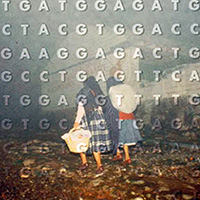“The method we developed changed DNA sequencing forever.”
Self Portrait in Ixuatio, 1988, to the left, contains the first automated DNA sequence ever made using PCR. It was made with my blood under an experiment that I requested of the scientists at Applied Biosystems in 1988. I required a DNA sequencing method that revealed something specific to the individual, a sequence of part of the person’s basic physical identity. DNA has been sequenced using this method ever since. The results of the experiment were published in The Journal of Clinical Chemistry, Vol. 35, No. 11, 1989, nearly a year after I made this Self Portrait using my own DNA. I am credited on page 5 of the publication, titled “Automated DNA Sequencing Methods Involving Polymerase Chain Reaction”.
Welcome to Works; DNA
Fifteenth Century Chinese painting is known for its combination of a painted metaphoric image combined with calligraphy. My portraits use the DNA sequence as hereditary calligraphy, combined with a metaphoric image that I create with photography. The metaphor explores unseen aspects of the person portrayed.
In all of these portraits the supposedly objective identity of the individual is reconsidered and portrayed with a subjective motif. I substitute a literal representation of a sitter with a subjective pictorial theme I select, compose, and photograph. I subvert the traditional mode of photographic representation with poetic metaphor and suggestion. My portraits open up associative areas for interpretation that go far beyond simple identification. The images I compose grow out of my discreet and harmonious interactions with the subject/sitter…. What also connects these portraits is the apparently universal syntax of DNA sequencing and the supposedly objective quality of photography as well as a deeply personal approach that opens up the portraits in terms of a context for deliberately subjective and associative inferences.
Through an inversion process that informs my work, positive pictures become like negatives, the invisible is made visible through the genetic code, and the negative image is developed on positive photographic paper, all of which are inversions of the common approach to photography. It would be misleading to read this inversion as impacting only medium and technique. Above all, this process deals with attributes and their depiction as well as the myth of objective representation.
How it all began
In 1988 I contacted Applied Biosystems, the leading manufacturer of DNA sequencing instruments and persuaded them to create a new DNA sequencing procedure that would be non comparative, thus useful for my portrait experiments. The results of their work, done using whole blood which I gave the research team, was published a year later: Automated DNA Sequencing Methods Involving Polymerase Chain Reaction. Clinical Chemistry, Vol. 35, No. 11, 1989. Applied Biosystems sent me an electropherogram of my sequence prior to publication and I was able to make my “Self-Portrait in Ixuatio” using my own sequence, a first. Since then, this procedure has become the standard for DNA sequencing throughout the world much as the keyboard has become a standard way of using a computer.
The early series, 1989-1995 included people I knew at the time and includes artists Jeff Koons, Peter Halley, Russell Maltz, Marion Zazeela and LaMonte Young, Ana Pellicer, Garance, Mel Chin, and Jacques Lowe, among others. The portrait of my late wife Janet, who died of breast cancer, was made in happier days, while this later portrait revealed darker portents yet celebrates her life nonetheless.
None of these portraits were commissioned, nor was my multi-paneled Portrait of John Cage, 1993-1996. The work did inspire Volker Rattemeyer, Director of the Museum Wiesbaden, to commission two sets of 13 portraits in 1997 for an exhibition date which happened to coincide with the millennium and unexpectedly, with the publishing of the human genome project.
Click here to explore additional DNA Clinical Chemistry.
Recent Works
Recent works include Kurt Schwitters, RAZOR, my Portrait of Joseph Beuys, works from a collaboration with artist and musician Charlemagne Palestine, and several commissioned portraits.
Early Works
Early works include my Self Portrait in Ixhatio (1988), Portrait of Janet Hasper (1988) some Chromoportraits, and a series called Tertulia or From the Blood of Poets, Taken, Literally. Portraits include Ana Pellicer, Richard Milazzo, Tricia Collins, Mel Chin, Jeff Koons, Peter Halley, Marian Zazeela, and LaMonte Young. An additional project featuring Portraits of John Cage and Merce Cunningham followed.
The commission from the Museum Wiesbaden to create The Invisible Body allowed me complete freedom to choose and portray people from both The Rhein-Main region of which Wiesbaden is a part and my native New York. I employed the conceptual basis, the scaffolding, as it were, of Leonardo’s Last Supper: twelve portraits plus one Leitmotiv portrait establishing the major theme of the set. My 12 +1 theme for New York included portraits of artists William N. Copley, Charlemagne Palestine, Nam June Paik, and Merce Cunningham, Eiko Ishioka, and Miquel Algarin. I also dedicated an entire series to the American scientist James D. Watson, one of the discoverers of the double helix structure of DNA. Portraits of Rev. Al Sharpton and Dachau survivor Yakob Polishchuck were also of interest.
My series of 13 portraits made in and around Wiesbaden and Frankfurt is different. Famous names do not leap out from this series, as the region, while rich in tradition, love of culture, and deeply Germanic mythologies, and a financial metropole and home address of the Euro, does not foster an environment suited to celebrity. Here are portraits of Adolph von Ribbentrop, son of Hitler’s infamous Foreign Minister, Dr. Peter von Seck, Fluxus collectors Michael and Ute Berger, vintner Armin Diel, and German SDS founder and publisher, KD Wolff.
Later Works
Later DNA works include portraits made between 1995-2010, excluding The Invisible Body and Works for the B-W Bank and 9/11 Dust to DNA.
Projects featured include Genetic Reveries, Becoming Human, and NewCircles.

